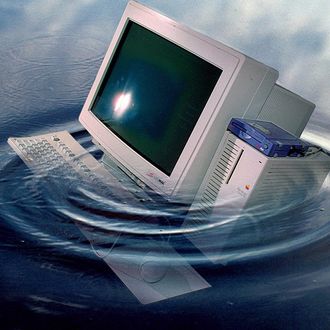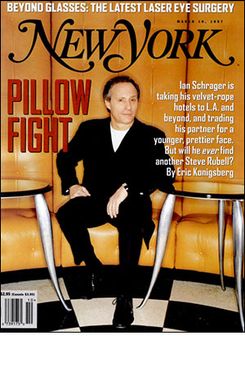
The New Old Media: Internet Entrepreneurs are finding that the Next Big Thing is … branching into “old” media to make a buck. Isn’t it ironic?

*From the March 10, 1997 issue of New York Magazine.
Internet entrepreneurs are finding that the Next Big Thing is…branching into “old” media to make a buck. Isn’t it ironic.
It’s coming-of-age time in Silicon Alley, that amorphous downtown hub where the Young Turks of new media churn out websites, CD-ROMS, and all things interactive. The boundless idealism, fluid cash flow, and fierce independence that characterized New York’s online industry in years gone by—that is, last year and maybe the year before—have given away to hard-nosed pragmatism, tight financial reins, and a willingness to forge strategic alliances with big business.
What’s more, there seems to be a newfound respect for old media, or at least the profits that can be made there. In fact, many cash-strapped content producers are trying to translate their nascent Internet identities into traditional media products. “The holy grail right now is to take a Web brand and leverage it in other media, like print, radio, and TV,” says Jason McCabe Calacanis, editor and publisher of the Silicon Alley Reporter, an industry newsletter.
Maybe that’s what multimedia meant all along. Yet not long ago, the digerati found old media to be, well, old. Books, magazines, shows, films—these ways of communicating were expensive, slow, and centralized. They weren’t interactive or digital or conducive to self-publishing the way the Web was. They weren’t the Next Big Thing.
By now, though, new-media entrepreneurs have realized that there isn’t much money yet to be made in Internet content. (Things have been better for companies providing Net-related technology, software, and consulting.). The main problem is that there aren’t enough eyeballs online to satisfy advertisers, who have approached the Web cautiously, spending about $320 million during 1996—less than one percent of what they spent on TV ads. (What’s more, the biggest advertisers on the Web turn out to be other Websites, creating even more of a financial vacuum within the industry.). The other basic way to make money online is via subscriptions, but few customers are yet willing to pay for content on the Net. So what’s a pioneer of online culture to do? Quite simple: Hedge your bets and go offline.
“At this point, I wouldn’t even entertain a project that only had a life as an online property,” says Tim Nye, the ambitious 30-year-old head of Sunshine Interactive Network. Nye recently sold a dramatic episodic series called The Vanishing Point to Microsoft for use on its online network, MSN. But Microsoft is also allowing him to develop a television version of the show, which revolves around a secret society, and he says he’s near a deal with one of the big three TV networks. “We’re not betting the farm on any one medium,” Nye says.
Others agree, saying there’s a need to spread the cost and risk associated with online media to offline ventures. N2K is an Internet-based entertainment company that sells CDs via the Web. Led by three veteran recording executives, the Silicon Alley company attracted attention last September when it persuaded David Bowie to release a single exclusively over the New. Some 240,000 copies were downloaded—for free—by listeners in 87 countries, according to vice-chairman Jon diamond. Revolutionary? Yes. A big moneymaker? Not really. So it’s not surprising that N2K is expanding into traditional media. In November, it started a record label with legendary producer Phil Ramone at the helm.
SonicNet, an acclaimed alternative-music Website based in lower Manhattan (founded, but no longer owned, by Tim Nye), is developing radio programming and a campus tour of rock and hip-hop acts. Music-oriented books, syndicated print, and TV programs are also in the works. Editor-in-chief Nicholas Butterworth (note the old-media title) says the fact that SonicNet already delivers audio and video online means that “the jump from what we do to radio and TV is not that big.” Indeed, the company’s ability to bring its growing audience of young, urban, affluent consumers to traditional media was one factor that made it an attractive acquisition for Paradigm Music Entertainment, an upstart record and radio company that bought the two-year-old SonicNet in January. Butterworth hopes to use his analog efforts to attract new customers to SonicNet’s digital home on the Internet, but notes that the real prize in old media is money. “You can’t support a Web business on advertising alone. You’ve got to look elsewhere,” he says.
The desire among these downtown companies to be players in paleomedia may not be surprising given that New York is a global center for all publishing and entertainment. Yet Silicon Alley is actually taking its cues from industry leaders outside New York who’ve already begun blazing the path from new media back to old. The creators of America Online’s Motley Fool financial service have published a best-selling book outlining their investment strategy and, until recently, ran a monthly column in Smart Money. Yahoo, the Web’s first popular search engine, now boasts a magazine, Yahoo! Internet Life. Microsoft’s e-zine Slate, which canned its plans to charge online readers, is offering a print version—for $70 a year. CNET, a Web-based news company, has launched four syndicated television shows about cyber life. And Wired Ventures, publishers of Wired magazine and the online service Hotwired, recently started a book-publishing imprint, a television show, and a news wire.
In one sense, the direction of all this movement seems counterintuitive. Just months ago, the buzz was that loyalists of traditional media were signing up for the digital revolution. (See, for example, Michael Kinsley leaving CNN for Slate, or MTV founder Bob Pittman going to AOL.) In another sense, though, there’s a logic to it. It’s not so much that talent is moving from one media sector to another but that various media categories are blurring. Already, “push” and “Webcasting” technologies—which bring images directly to your computer screen, instead of waiting for the mouse’s all-powerful click—are making the Web a lot more like TV. And with developments like interactive digital TV and channels like MSNBC, it’s hard to say where TV ends and the Internet begins.
There’s even a reluctance among new-media start-ups to be identified solely with the Internet. Dan Pelson, a co-founder of the online literary magazine Word, chooses his terms carefully when describing his new venture, Concrete Media, which so far has two Web-based properties: “We’re not an Internet company. We’re a media company that happens to have its expertise on the Internet.”
The crossover from new to old media can also be seen as part of a larger recent trend in contemporary entertainment toward multiple-medium, synergistic marketing. Particularly for megaconglomerates, it’s not uncommon to take one story line and make a film, release a soundtrack, spin off a book, launched a TV show, maybe put up a Broadway show. Cyber folk just seem to be catching up.
Or so it would seem. Some in New York’s new media scene claim they always saw the Internet as a cheap way to establish an identity that could be leveraged in other venues. “I never thought the Net could sustain us,” says Aliza Sherman, creator of a number of women-centered sites, including an online cartoon called Cybergrrl. “The technology is too primitive.” Sherman, who launched her business from her Manhattan apartment, now has a book deal and is considering TV offers.
This integration of old and new media may turn out to be a financial boon for the Web. But it may also be a sign that the Internet is entering an age of diminished expectations. Steven Johnson, editor of the successful online journal Feed, maintains that sites like his have attracted a solid audience and substantial advertising by being realistic about the medium’s limitations and capitalizing on its unique features (for example, the ability to build community online and the use of hypertext links to expose visitors to a wide array of material). Unlike some starry-eyes companies that added scores of staff members overnight and expected to generate Microsoft-like earnings, Johnson and Feed co-founder Stefanie Syman have hired few employees, established relationships with a variety of e-zines and with the New York Times online, and kept a sense of perspective. For example, while some analysts expect new-media companies to be profitable in twelve to eighteen months, Johnson and Syman note that it takes most start-up magazines and newspapers three to five years to make a profit—and Feed expects to be in the black after only two years.
It’s hard to argue with Feed’s levelheaded approach. But with all the savvy cross-platform strategizing now underway, one wonders about the fate of small websites that lack the clout to enter traditional media and reap profits. Will they be able to survive until the Web matures? It’s also not clear whether their bigger, synergy-minded counterparts are even planning to wait it out, or if they just see the Web as one big marketing tool to be discarded once other old media products take off.
No doubt, some good may come of this cross-pollination, but the fear of new-media die-hards is that those who go offline will fall prey to traditional media weaknesses: a tendency toward homogeneity, passivity, and dumbed-down material. Worst of all is the possibility that the Web will be reduced to simply another outlet in which—or from which—to exploit “branded content.” If this occurs, much potential will have been squandered, and what’s supposed to be the cutting edge of our cultural expression may get painfully dull.





























